Legal Provisions and Impact on Business - Carters LLP
VerifiedAdded on 2022/12/09
|12
|3936
|494
AI Summary
This study focuses on the legal provisions and their impact on business, specifically in the context of Carters LLP. It covers topics such as different sources of law, the role of government in law making, the impact of laws on business, and the legal formation of different businesses. The study provides insights into how these legal aspects affect the operations and management of Carters LLP.
Contribute Materials
Your contribution can guide someone’s learning journey. Share your
documents today.
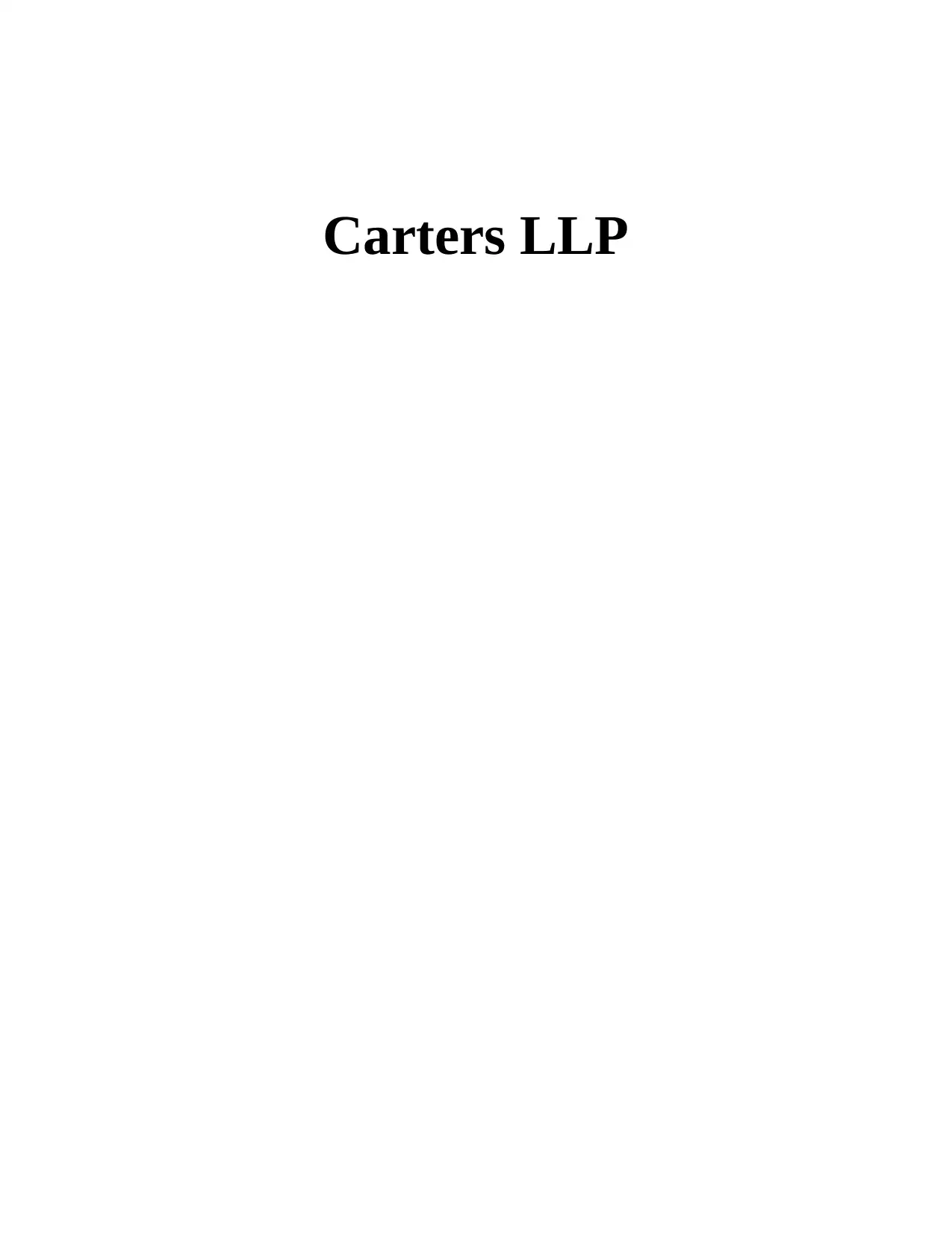
Carters LLP
Secure Best Marks with AI Grader
Need help grading? Try our AI Grader for instant feedback on your assignments.
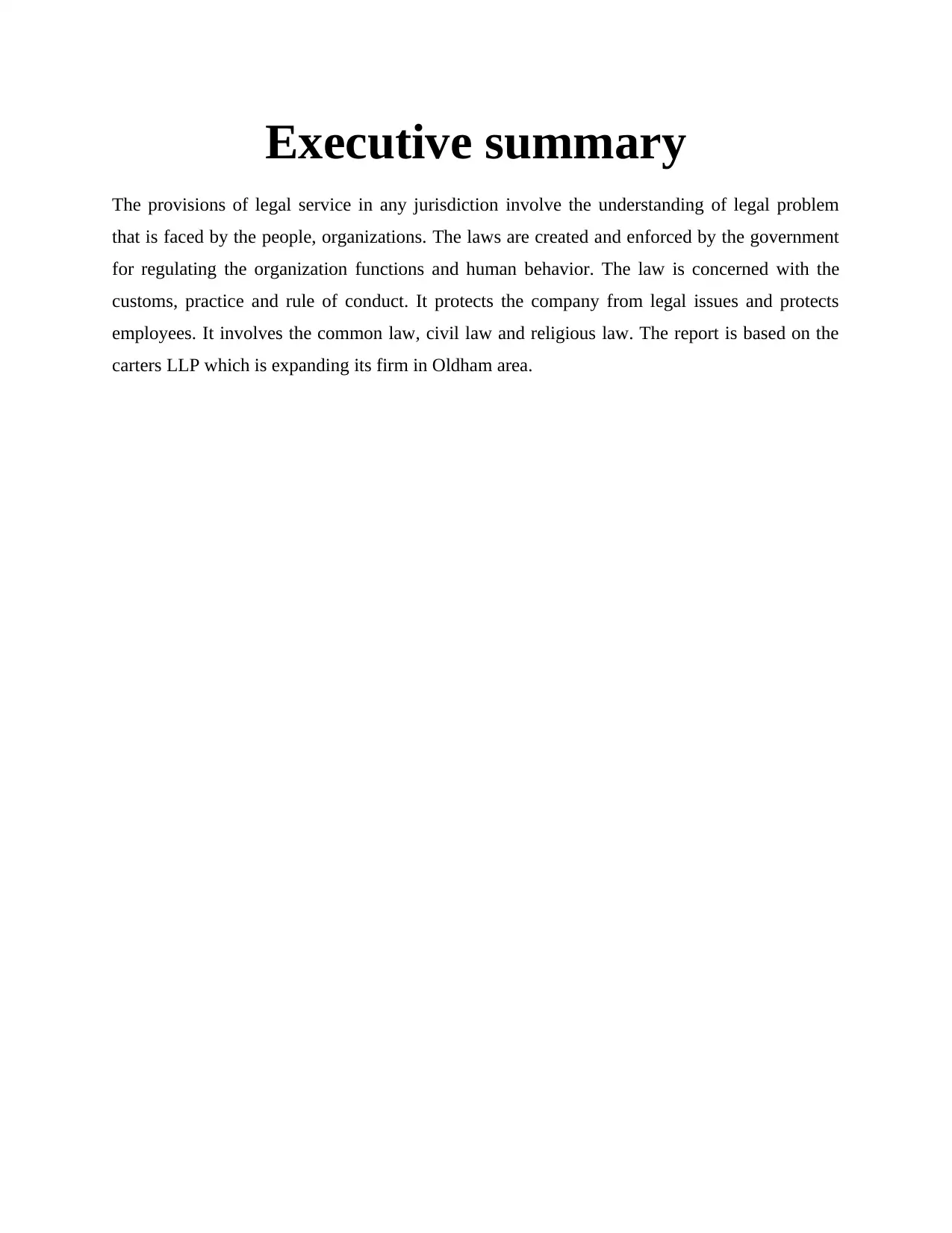
Executive summary
The provisions of legal service in any jurisdiction involve the understanding of legal problem
that is faced by the people, organizations. The laws are created and enforced by the government
for regulating the organization functions and human behavior. The law is concerned with the
customs, practice and rule of conduct. It protects the company from legal issues and protects
employees. It involves the common law, civil law and religious law. The report is based on the
carters LLP which is expanding its firm in Oldham area.
The provisions of legal service in any jurisdiction involve the understanding of legal problem
that is faced by the people, organizations. The laws are created and enforced by the government
for regulating the organization functions and human behavior. The law is concerned with the
customs, practice and rule of conduct. It protects the company from legal issues and protects
employees. It involves the common law, civil law and religious law. The report is based on the
carters LLP which is expanding its firm in Oldham area.
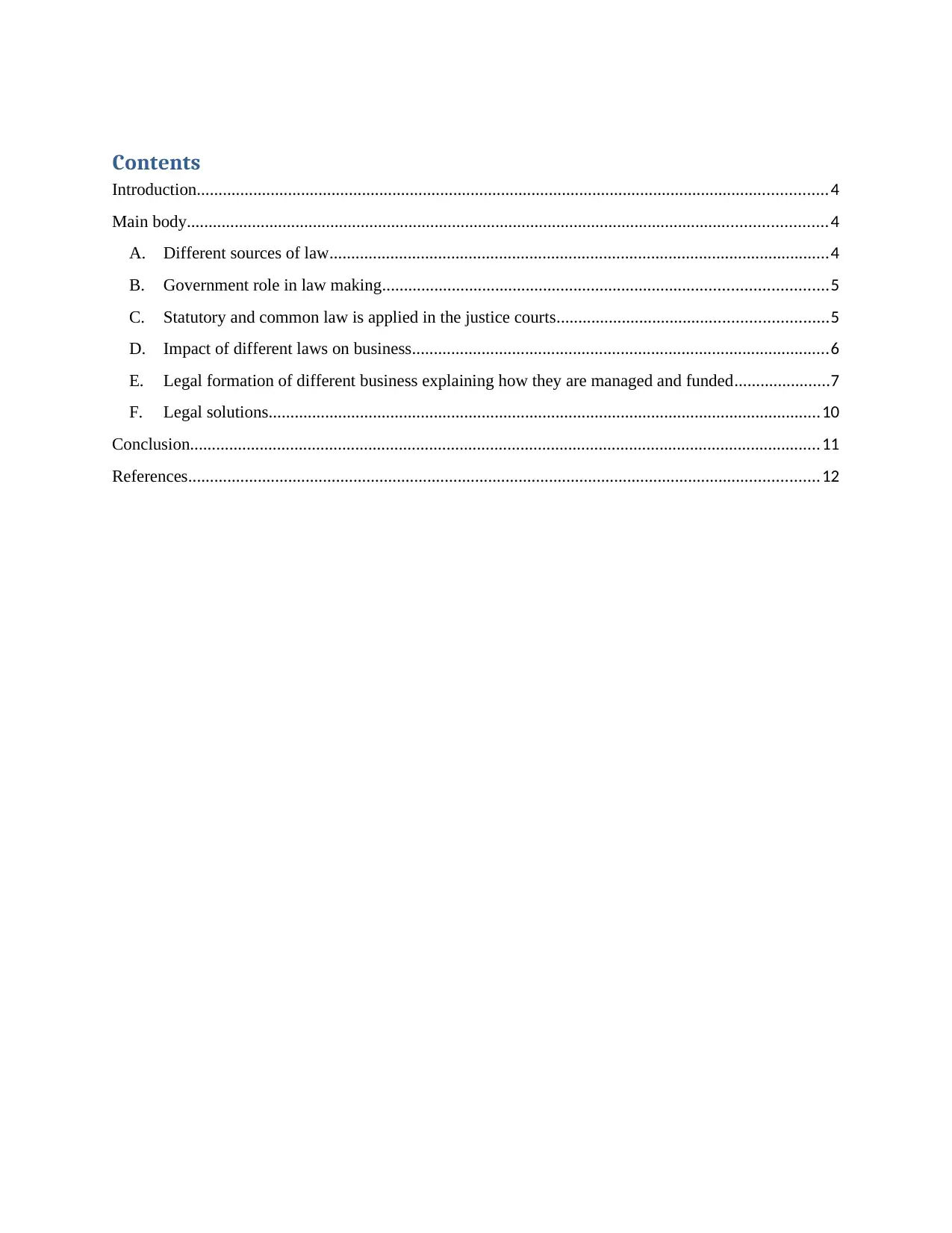
Contents
Introduction.................................................................................................................................................4
Main body...................................................................................................................................................4
A. Different sources of law...................................................................................................................4
B. Government role in law making......................................................................................................5
C. Statutory and common law is applied in the justice courts..............................................................5
D. Impact of different laws on business................................................................................................6
E. Legal formation of different business explaining how they are managed and funded......................7
F. Legal solutions...............................................................................................................................10
Conclusion.................................................................................................................................................11
References.................................................................................................................................................12
Introduction.................................................................................................................................................4
Main body...................................................................................................................................................4
A. Different sources of law...................................................................................................................4
B. Government role in law making......................................................................................................5
C. Statutory and common law is applied in the justice courts..............................................................5
D. Impact of different laws on business................................................................................................6
E. Legal formation of different business explaining how they are managed and funded......................7
F. Legal solutions...............................................................................................................................10
Conclusion.................................................................................................................................................11
References.................................................................................................................................................12
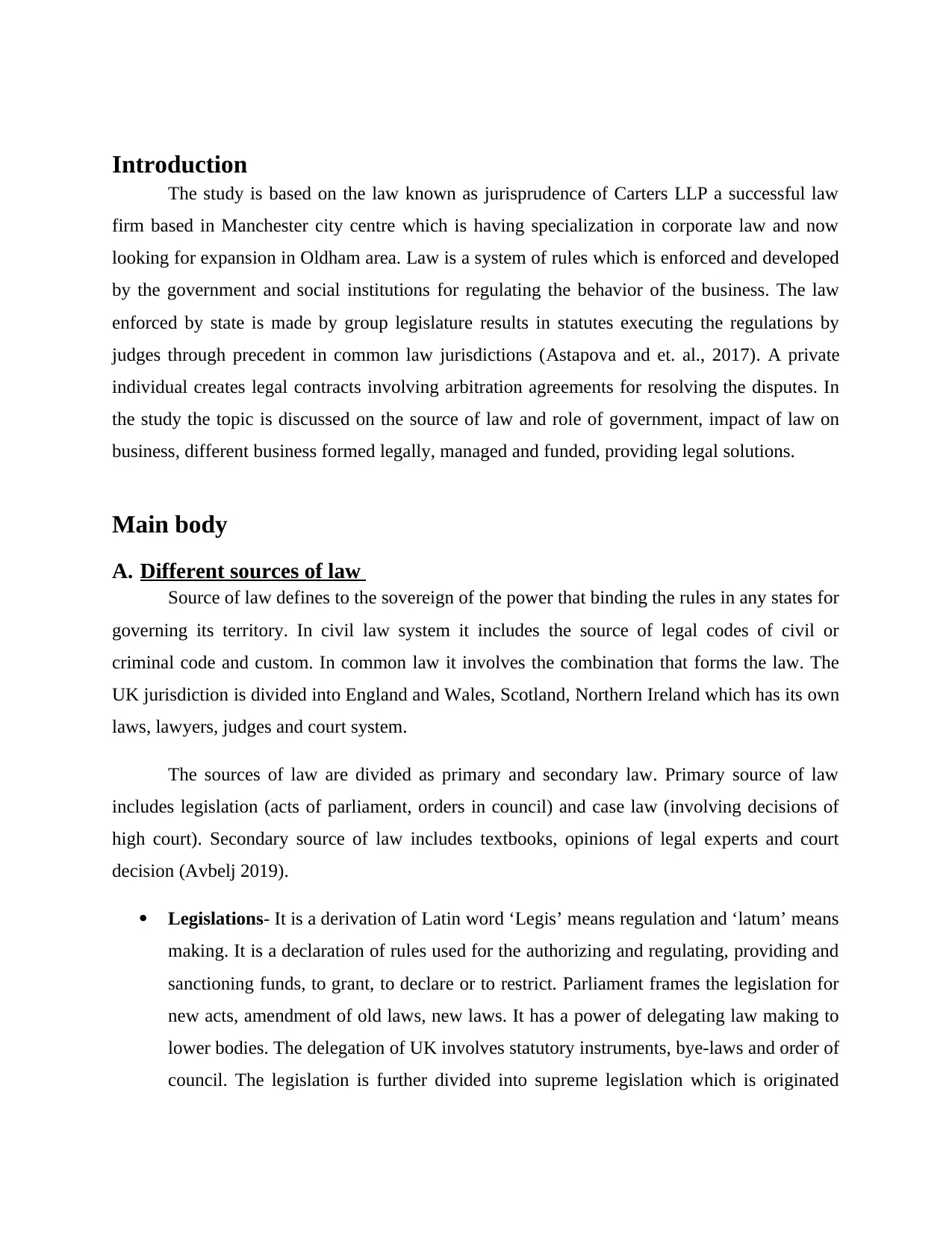
Introduction
The study is based on the law known as jurisprudence of Carters LLP a successful law
firm based in Manchester city centre which is having specialization in corporate law and now
looking for expansion in Oldham area. Law is a system of rules which is enforced and developed
by the government and social institutions for regulating the behavior of the business. The law
enforced by state is made by group legislature results in statutes executing the regulations by
judges through precedent in common law jurisdictions (Astapova and et. al., 2017). A private
individual creates legal contracts involving arbitration agreements for resolving the disputes. In
the study the topic is discussed on the source of law and role of government, impact of law on
business, different business formed legally, managed and funded, providing legal solutions.
Main body
A. Different sources of law
Source of law defines to the sovereign of the power that binding the rules in any states for
governing its territory. In civil law system it includes the source of legal codes of civil or
criminal code and custom. In common law it involves the combination that forms the law. The
UK jurisdiction is divided into England and Wales, Scotland, Northern Ireland which has its own
laws, lawyers, judges and court system.
The sources of law are divided as primary and secondary law. Primary source of law
includes legislation (acts of parliament, orders in council) and case law (involving decisions of
high court). Secondary source of law includes textbooks, opinions of legal experts and court
decision (Avbelj 2019).
Legislations- It is a derivation of Latin word ‘Legis’ means regulation and ‘latum’ means
making. It is a declaration of rules used for the authorizing and regulating, providing and
sanctioning funds, to grant, to declare or to restrict. Parliament frames the legislation for
new acts, amendment of old laws, new laws. It has a power of delegating law making to
lower bodies. The delegation of UK involves statutory instruments, bye-laws and order of
council. The legislation is further divided into supreme legislation which is originated
The study is based on the law known as jurisprudence of Carters LLP a successful law
firm based in Manchester city centre which is having specialization in corporate law and now
looking for expansion in Oldham area. Law is a system of rules which is enforced and developed
by the government and social institutions for regulating the behavior of the business. The law
enforced by state is made by group legislature results in statutes executing the regulations by
judges through precedent in common law jurisdictions (Astapova and et. al., 2017). A private
individual creates legal contracts involving arbitration agreements for resolving the disputes. In
the study the topic is discussed on the source of law and role of government, impact of law on
business, different business formed legally, managed and funded, providing legal solutions.
Main body
A. Different sources of law
Source of law defines to the sovereign of the power that binding the rules in any states for
governing its territory. In civil law system it includes the source of legal codes of civil or
criminal code and custom. In common law it involves the combination that forms the law. The
UK jurisdiction is divided into England and Wales, Scotland, Northern Ireland which has its own
laws, lawyers, judges and court system.
The sources of law are divided as primary and secondary law. Primary source of law
includes legislation (acts of parliament, orders in council) and case law (involving decisions of
high court). Secondary source of law includes textbooks, opinions of legal experts and court
decision (Avbelj 2019).
Legislations- It is a derivation of Latin word ‘Legis’ means regulation and ‘latum’ means
making. It is a declaration of rules used for the authorizing and regulating, providing and
sanctioning funds, to grant, to declare or to restrict. Parliament frames the legislation for
new acts, amendment of old laws, new laws. It has a power of delegating law making to
lower bodies. The delegation of UK involves statutory instruments, bye-laws and order of
council. The legislation is further divided into supreme legislation which is originated
Secure Best Marks with AI Grader
Need help grading? Try our AI Grader for instant feedback on your assignments.
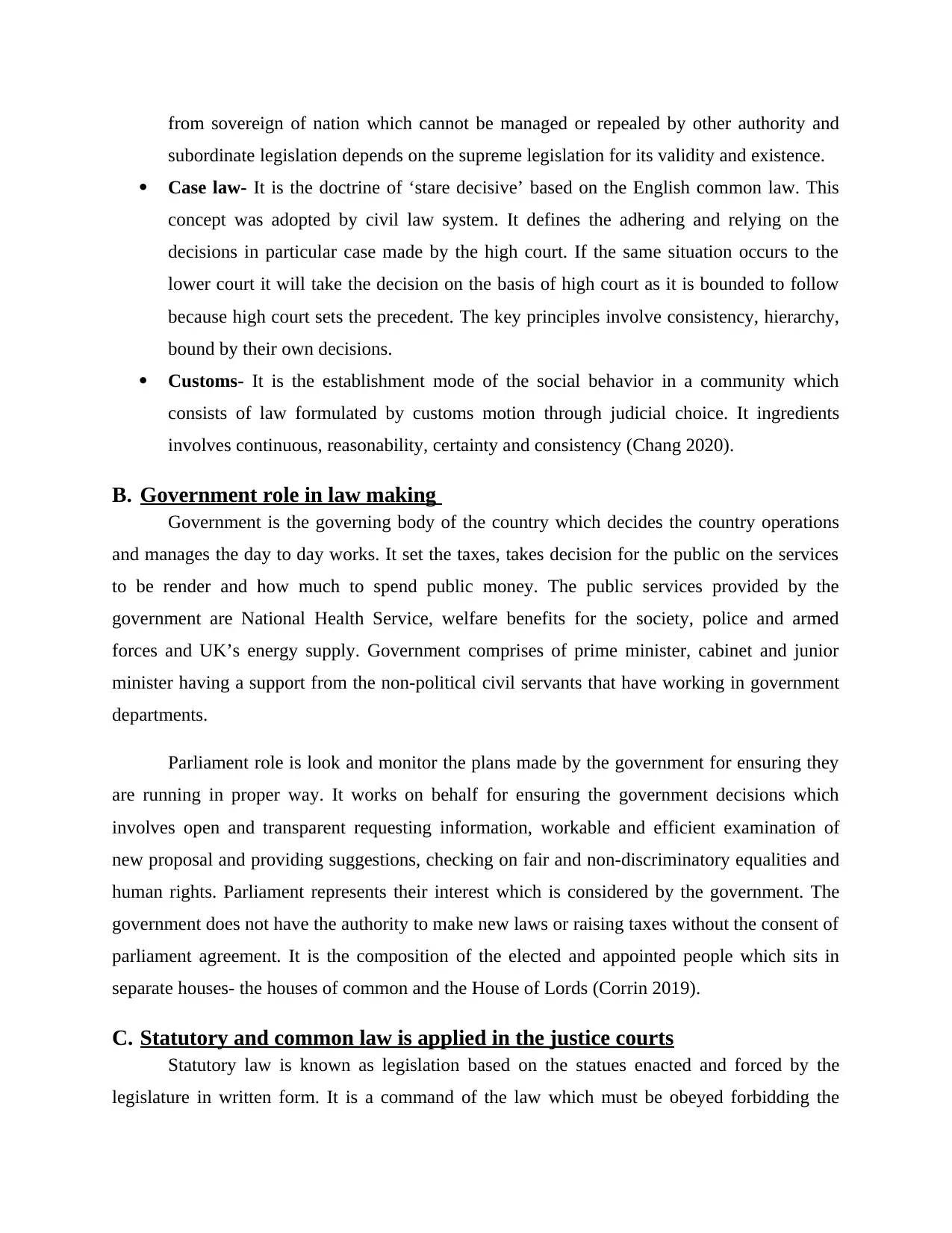
from sovereign of nation which cannot be managed or repealed by other authority and
subordinate legislation depends on the supreme legislation for its validity and existence.
Case law- It is the doctrine of ‘stare decisive’ based on the English common law. This
concept was adopted by civil law system. It defines the adhering and relying on the
decisions in particular case made by the high court. If the same situation occurs to the
lower court it will take the decision on the basis of high court as it is bounded to follow
because high court sets the precedent. The key principles involve consistency, hierarchy,
bound by their own decisions.
Customs- It is the establishment mode of the social behavior in a community which
consists of law formulated by customs motion through judicial choice. It ingredients
involves continuous, reasonability, certainty and consistency (Chang 2020).
B. Government role in law making
Government is the governing body of the country which decides the country operations
and manages the day to day works. It set the taxes, takes decision for the public on the services
to be render and how much to spend public money. The public services provided by the
government are National Health Service, welfare benefits for the society, police and armed
forces and UK’s energy supply. Government comprises of prime minister, cabinet and junior
minister having a support from the non-political civil servants that have working in government
departments.
Parliament role is look and monitor the plans made by the government for ensuring they
are running in proper way. It works on behalf for ensuring the government decisions which
involves open and transparent requesting information, workable and efficient examination of
new proposal and providing suggestions, checking on fair and non-discriminatory equalities and
human rights. Parliament represents their interest which is considered by the government. The
government does not have the authority to make new laws or raising taxes without the consent of
parliament agreement. It is the composition of the elected and appointed people which sits in
separate houses- the houses of common and the House of Lords (Corrin 2019).
C. Statutory and common law is applied in the justice courts
Statutory law is known as legislation based on the statues enacted and forced by the
legislature in written form. It is a command of the law which must be obeyed forbidding the
subordinate legislation depends on the supreme legislation for its validity and existence.
Case law- It is the doctrine of ‘stare decisive’ based on the English common law. This
concept was adopted by civil law system. It defines the adhering and relying on the
decisions in particular case made by the high court. If the same situation occurs to the
lower court it will take the decision on the basis of high court as it is bounded to follow
because high court sets the precedent. The key principles involve consistency, hierarchy,
bound by their own decisions.
Customs- It is the establishment mode of the social behavior in a community which
consists of law formulated by customs motion through judicial choice. It ingredients
involves continuous, reasonability, certainty and consistency (Chang 2020).
B. Government role in law making
Government is the governing body of the country which decides the country operations
and manages the day to day works. It set the taxes, takes decision for the public on the services
to be render and how much to spend public money. The public services provided by the
government are National Health Service, welfare benefits for the society, police and armed
forces and UK’s energy supply. Government comprises of prime minister, cabinet and junior
minister having a support from the non-political civil servants that have working in government
departments.
Parliament role is look and monitor the plans made by the government for ensuring they
are running in proper way. It works on behalf for ensuring the government decisions which
involves open and transparent requesting information, workable and efficient examination of
new proposal and providing suggestions, checking on fair and non-discriminatory equalities and
human rights. Parliament represents their interest which is considered by the government. The
government does not have the authority to make new laws or raising taxes without the consent of
parliament agreement. It is the composition of the elected and appointed people which sits in
separate houses- the houses of common and the House of Lords (Corrin 2019).
C. Statutory and common law is applied in the justice courts
Statutory law is known as legislation based on the statues enacted and forced by the
legislature in written form. It is a command of the law which must be obeyed forbidding the
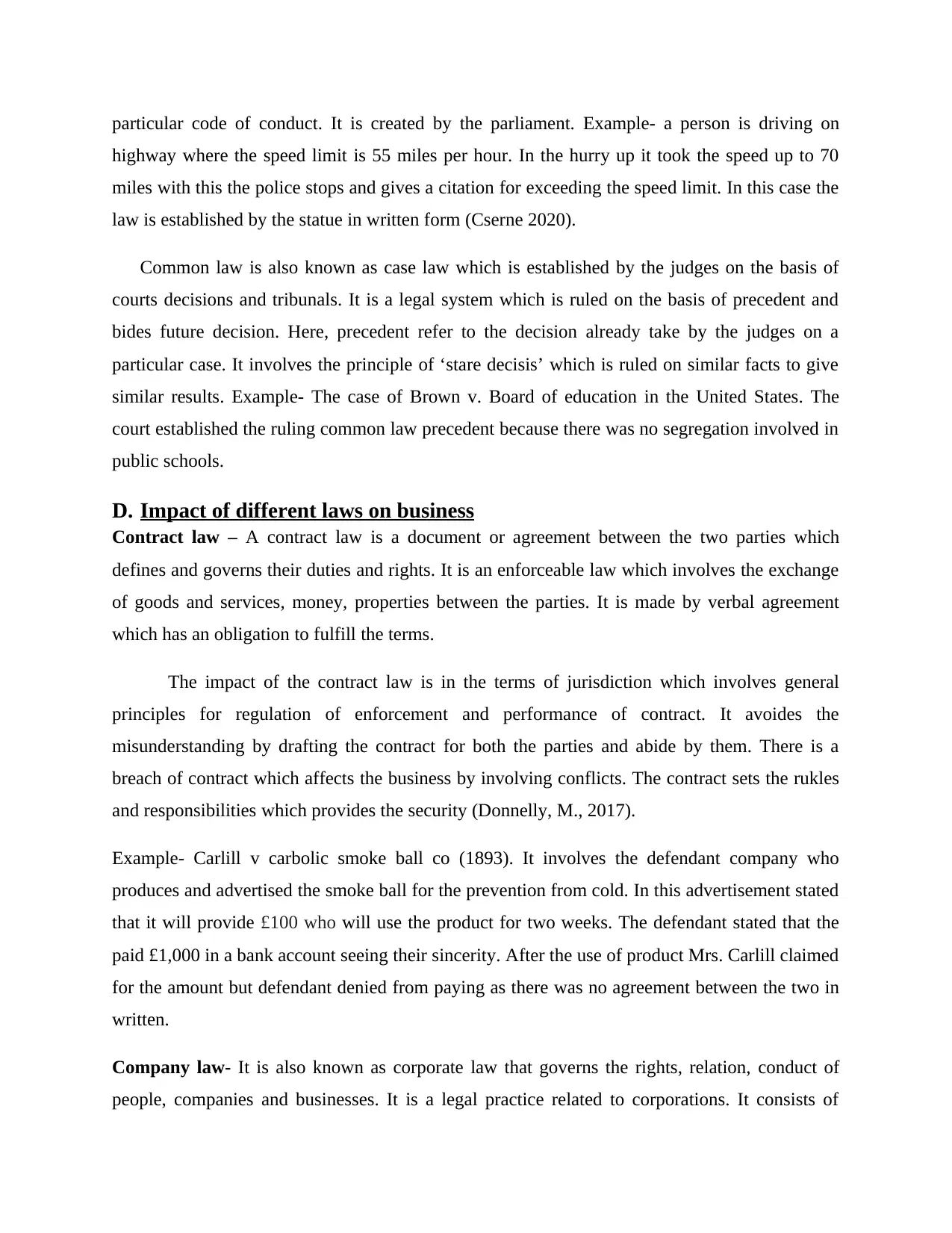
particular code of conduct. It is created by the parliament. Example- a person is driving on
highway where the speed limit is 55 miles per hour. In the hurry up it took the speed up to 70
miles with this the police stops and gives a citation for exceeding the speed limit. In this case the
law is established by the statue in written form (Cserne 2020).
Common law is also known as case law which is established by the judges on the basis of
courts decisions and tribunals. It is a legal system which is ruled on the basis of precedent and
bides future decision. Here, precedent refer to the decision already take by the judges on a
particular case. It involves the principle of ‘stare decisis’ which is ruled on similar facts to give
similar results. Example- The case of Brown v. Board of education in the United States. The
court established the ruling common law precedent because there was no segregation involved in
public schools.
D. Impact of different laws on business
Contract law – A contract law is a document or agreement between the two parties which
defines and governs their duties and rights. It is an enforceable law which involves the exchange
of goods and services, money, properties between the parties. It is made by verbal agreement
which has an obligation to fulfill the terms.
The impact of the contract law is in the terms of jurisdiction which involves general
principles for regulation of enforcement and performance of contract. It avoides the
misunderstanding by drafting the contract for both the parties and abide by them. There is a
breach of contract which affects the business by involving conflicts. The contract sets the rukles
and responsibilities which provides the security (Donnelly, M., 2017).
Example- Carlill v carbolic smoke ball co (1893). It involves the defendant company who
produces and advertised the smoke ball for the prevention from cold. In this advertisement stated
that it will provide £100 who will use the product for two weeks. The defendant stated that the
paid £1,000 in a bank account seeing their sincerity. After the use of product Mrs. Carlill claimed
for the amount but defendant denied from paying as there was no agreement between the two in
written.
Company law- It is also known as corporate law that governs the rights, relation, conduct of
people, companies and businesses. It is a legal practice related to corporations. It consists of
highway where the speed limit is 55 miles per hour. In the hurry up it took the speed up to 70
miles with this the police stops and gives a citation for exceeding the speed limit. In this case the
law is established by the statue in written form (Cserne 2020).
Common law is also known as case law which is established by the judges on the basis of
courts decisions and tribunals. It is a legal system which is ruled on the basis of precedent and
bides future decision. Here, precedent refer to the decision already take by the judges on a
particular case. It involves the principle of ‘stare decisis’ which is ruled on similar facts to give
similar results. Example- The case of Brown v. Board of education in the United States. The
court established the ruling common law precedent because there was no segregation involved in
public schools.
D. Impact of different laws on business
Contract law – A contract law is a document or agreement between the two parties which
defines and governs their duties and rights. It is an enforceable law which involves the exchange
of goods and services, money, properties between the parties. It is made by verbal agreement
which has an obligation to fulfill the terms.
The impact of the contract law is in the terms of jurisdiction which involves general
principles for regulation of enforcement and performance of contract. It avoides the
misunderstanding by drafting the contract for both the parties and abide by them. There is a
breach of contract which affects the business by involving conflicts. The contract sets the rukles
and responsibilities which provides the security (Donnelly, M., 2017).
Example- Carlill v carbolic smoke ball co (1893). It involves the defendant company who
produces and advertised the smoke ball for the prevention from cold. In this advertisement stated
that it will provide £100 who will use the product for two weeks. The defendant stated that the
paid £1,000 in a bank account seeing their sincerity. After the use of product Mrs. Carlill claimed
for the amount but defendant denied from paying as there was no agreement between the two in
written.
Company law- It is also known as corporate law that governs the rights, relation, conduct of
people, companies and businesses. It is a legal practice related to corporations. It consists of
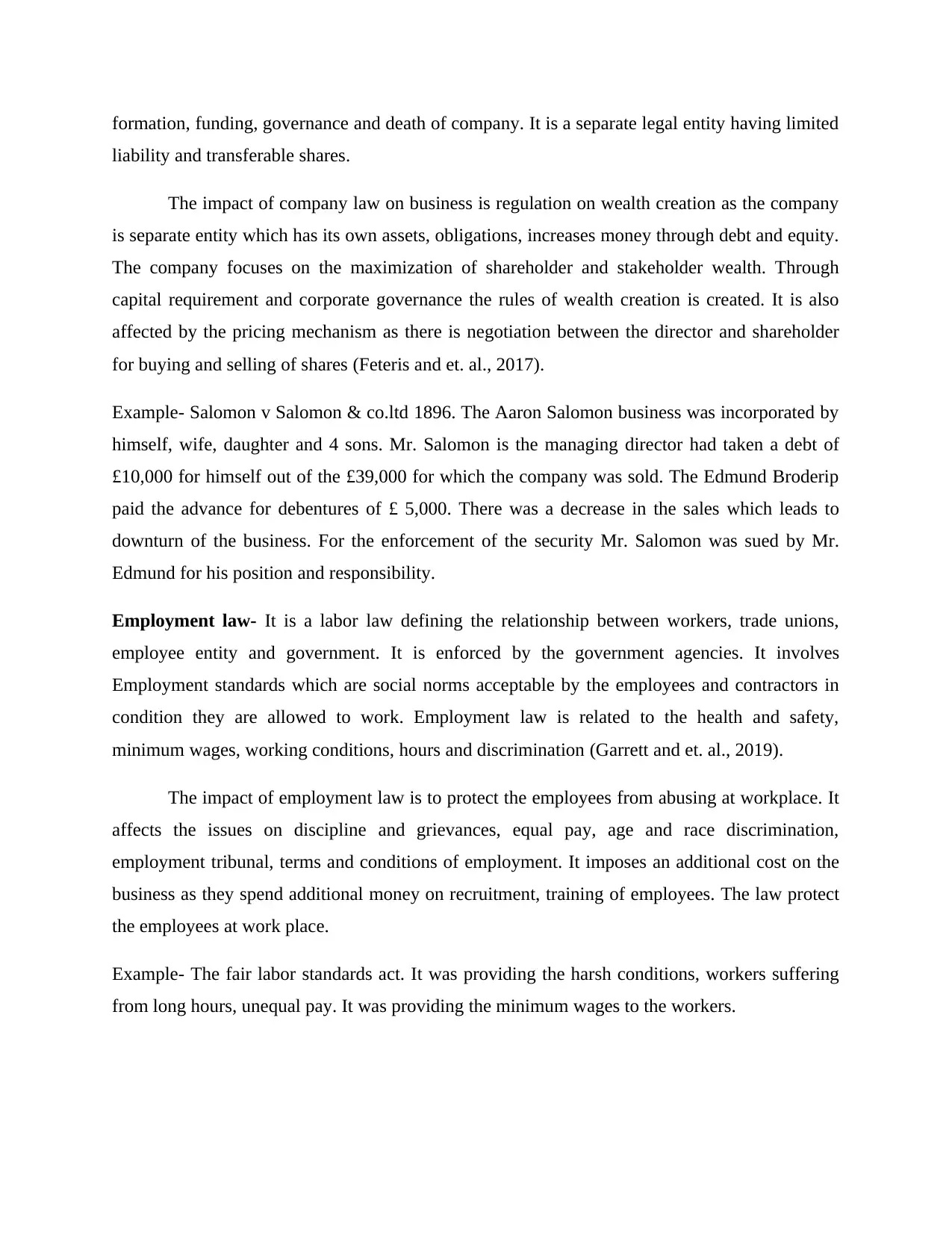
formation, funding, governance and death of company. It is a separate legal entity having limited
liability and transferable shares.
The impact of company law on business is regulation on wealth creation as the company
is separate entity which has its own assets, obligations, increases money through debt and equity.
The company focuses on the maximization of shareholder and stakeholder wealth. Through
capital requirement and corporate governance the rules of wealth creation is created. It is also
affected by the pricing mechanism as there is negotiation between the director and shareholder
for buying and selling of shares (Feteris and et. al., 2017).
Example- Salomon v Salomon & co.ltd 1896. The Aaron Salomon business was incorporated by
himself, wife, daughter and 4 sons. Mr. Salomon is the managing director had taken a debt of
£10,000 for himself out of the £39,000 for which the company was sold. The Edmund Broderip
paid the advance for debentures of £ 5,000. There was a decrease in the sales which leads to
downturn of the business. For the enforcement of the security Mr. Salomon was sued by Mr.
Edmund for his position and responsibility.
Employment law- It is a labor law defining the relationship between workers, trade unions,
employee entity and government. It is enforced by the government agencies. It involves
Employment standards which are social norms acceptable by the employees and contractors in
condition they are allowed to work. Employment law is related to the health and safety,
minimum wages, working conditions, hours and discrimination (Garrett and et. al., 2019).
The impact of employment law is to protect the employees from abusing at workplace. It
affects the issues on discipline and grievances, equal pay, age and race discrimination,
employment tribunal, terms and conditions of employment. It imposes an additional cost on the
business as they spend additional money on recruitment, training of employees. The law protect
the employees at work place.
Example- The fair labor standards act. It was providing the harsh conditions, workers suffering
from long hours, unequal pay. It was providing the minimum wages to the workers.
liability and transferable shares.
The impact of company law on business is regulation on wealth creation as the company
is separate entity which has its own assets, obligations, increases money through debt and equity.
The company focuses on the maximization of shareholder and stakeholder wealth. Through
capital requirement and corporate governance the rules of wealth creation is created. It is also
affected by the pricing mechanism as there is negotiation between the director and shareholder
for buying and selling of shares (Feteris and et. al., 2017).
Example- Salomon v Salomon & co.ltd 1896. The Aaron Salomon business was incorporated by
himself, wife, daughter and 4 sons. Mr. Salomon is the managing director had taken a debt of
£10,000 for himself out of the £39,000 for which the company was sold. The Edmund Broderip
paid the advance for debentures of £ 5,000. There was a decrease in the sales which leads to
downturn of the business. For the enforcement of the security Mr. Salomon was sued by Mr.
Edmund for his position and responsibility.
Employment law- It is a labor law defining the relationship between workers, trade unions,
employee entity and government. It is enforced by the government agencies. It involves
Employment standards which are social norms acceptable by the employees and contractors in
condition they are allowed to work. Employment law is related to the health and safety,
minimum wages, working conditions, hours and discrimination (Garrett and et. al., 2019).
The impact of employment law is to protect the employees from abusing at workplace. It
affects the issues on discipline and grievances, equal pay, age and race discrimination,
employment tribunal, terms and conditions of employment. It imposes an additional cost on the
business as they spend additional money on recruitment, training of employees. The law protect
the employees at work place.
Example- The fair labor standards act. It was providing the harsh conditions, workers suffering
from long hours, unequal pay. It was providing the minimum wages to the workers.
Paraphrase This Document
Need a fresh take? Get an instant paraphrase of this document with our AI Paraphraser
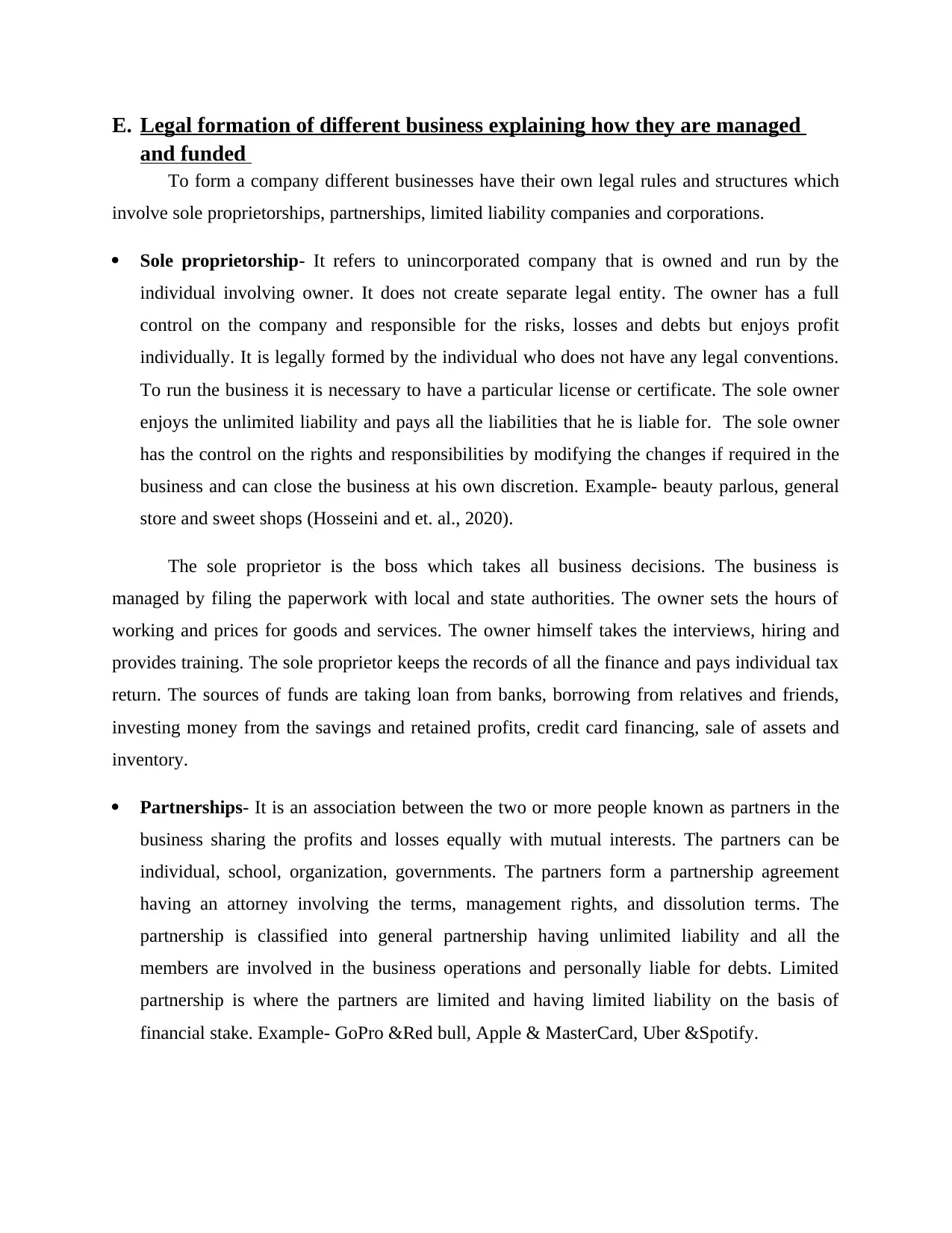
E. Legal formation of different business explaining how they are managed
and funded
To form a company different businesses have their own legal rules and structures which
involve sole proprietorships, partnerships, limited liability companies and corporations.
Sole proprietorship- It refers to unincorporated company that is owned and run by the
individual involving owner. It does not create separate legal entity. The owner has a full
control on the company and responsible for the risks, losses and debts but enjoys profit
individually. It is legally formed by the individual who does not have any legal conventions.
To run the business it is necessary to have a particular license or certificate. The sole owner
enjoys the unlimited liability and pays all the liabilities that he is liable for. The sole owner
has the control on the rights and responsibilities by modifying the changes if required in the
business and can close the business at his own discretion. Example- beauty parlous, general
store and sweet shops (Hosseini and et. al., 2020).
The sole proprietor is the boss which takes all business decisions. The business is
managed by filing the paperwork with local and state authorities. The owner sets the hours of
working and prices for goods and services. The owner himself takes the interviews, hiring and
provides training. The sole proprietor keeps the records of all the finance and pays individual tax
return. The sources of funds are taking loan from banks, borrowing from relatives and friends,
investing money from the savings and retained profits, credit card financing, sale of assets and
inventory.
Partnerships- It is an association between the two or more people known as partners in the
business sharing the profits and losses equally with mutual interests. The partners can be
individual, school, organization, governments. The partners form a partnership agreement
having an attorney involving the terms, management rights, and dissolution terms. The
partnership is classified into general partnership having unlimited liability and all the
members are involved in the business operations and personally liable for debts. Limited
partnership is where the partners are limited and having limited liability on the basis of
financial stake. Example- GoPro &Red bull, Apple & MasterCard, Uber &Spotify.
and funded
To form a company different businesses have their own legal rules and structures which
involve sole proprietorships, partnerships, limited liability companies and corporations.
Sole proprietorship- It refers to unincorporated company that is owned and run by the
individual involving owner. It does not create separate legal entity. The owner has a full
control on the company and responsible for the risks, losses and debts but enjoys profit
individually. It is legally formed by the individual who does not have any legal conventions.
To run the business it is necessary to have a particular license or certificate. The sole owner
enjoys the unlimited liability and pays all the liabilities that he is liable for. The sole owner
has the control on the rights and responsibilities by modifying the changes if required in the
business and can close the business at his own discretion. Example- beauty parlous, general
store and sweet shops (Hosseini and et. al., 2020).
The sole proprietor is the boss which takes all business decisions. The business is
managed by filing the paperwork with local and state authorities. The owner sets the hours of
working and prices for goods and services. The owner himself takes the interviews, hiring and
provides training. The sole proprietor keeps the records of all the finance and pays individual tax
return. The sources of funds are taking loan from banks, borrowing from relatives and friends,
investing money from the savings and retained profits, credit card financing, sale of assets and
inventory.
Partnerships- It is an association between the two or more people known as partners in the
business sharing the profits and losses equally with mutual interests. The partners can be
individual, school, organization, governments. The partners form a partnership agreement
having an attorney involving the terms, management rights, and dissolution terms. The
partnership is classified into general partnership having unlimited liability and all the
members are involved in the business operations and personally liable for debts. Limited
partnership is where the partners are limited and having limited liability on the basis of
financial stake. Example- GoPro &Red bull, Apple & MasterCard, Uber &Spotify.
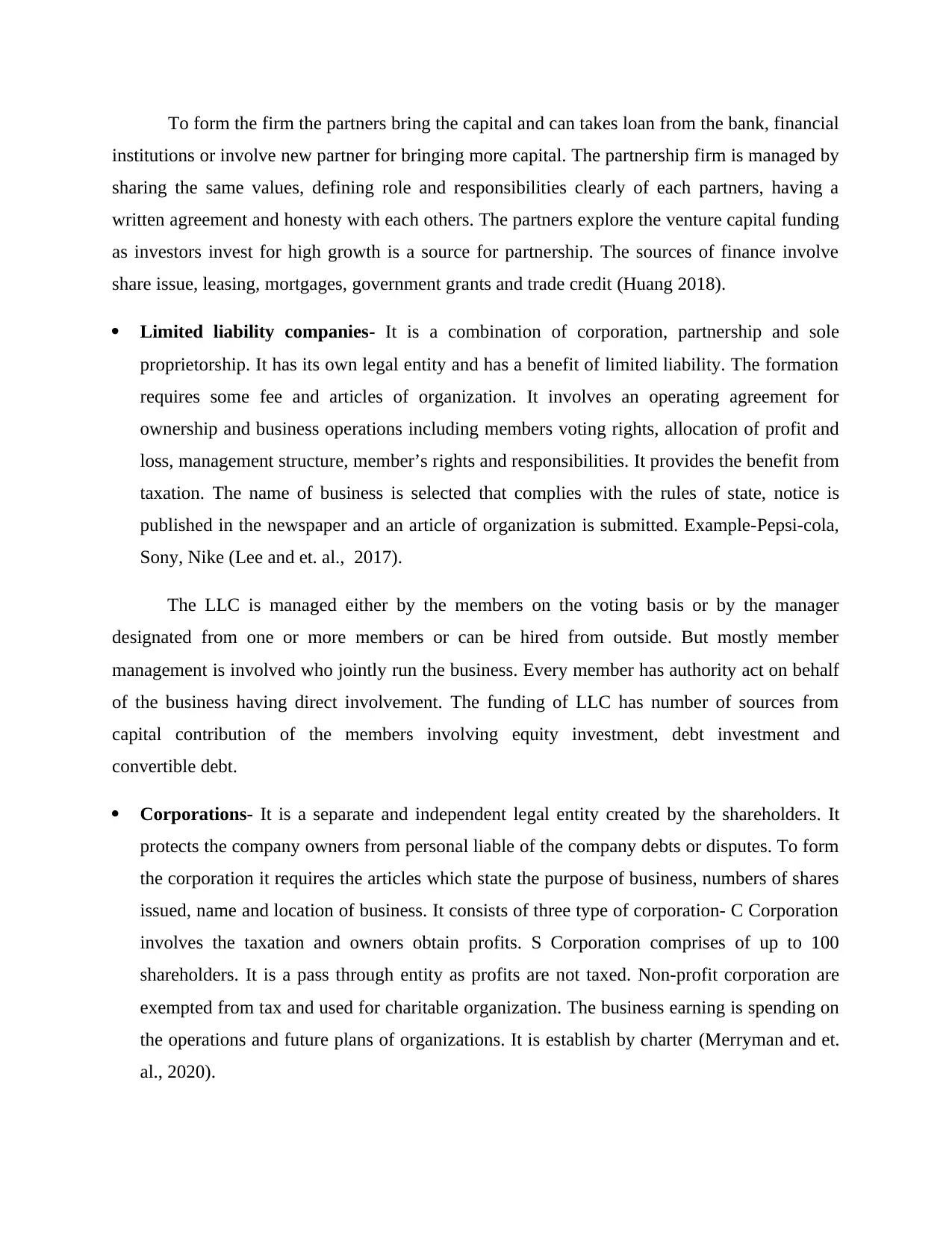
To form the firm the partners bring the capital and can takes loan from the bank, financial
institutions or involve new partner for bringing more capital. The partnership firm is managed by
sharing the same values, defining role and responsibilities clearly of each partners, having a
written agreement and honesty with each others. The partners explore the venture capital funding
as investors invest for high growth is a source for partnership. The sources of finance involve
share issue, leasing, mortgages, government grants and trade credit (Huang 2018).
Limited liability companies- It is a combination of corporation, partnership and sole
proprietorship. It has its own legal entity and has a benefit of limited liability. The formation
requires some fee and articles of organization. It involves an operating agreement for
ownership and business operations including members voting rights, allocation of profit and
loss, management structure, member’s rights and responsibilities. It provides the benefit from
taxation. The name of business is selected that complies with the rules of state, notice is
published in the newspaper and an article of organization is submitted. Example-Pepsi-cola,
Sony, Nike (Lee and et. al., 2017).
The LLC is managed either by the members on the voting basis or by the manager
designated from one or more members or can be hired from outside. But mostly member
management is involved who jointly run the business. Every member has authority act on behalf
of the business having direct involvement. The funding of LLC has number of sources from
capital contribution of the members involving equity investment, debt investment and
convertible debt.
Corporations- It is a separate and independent legal entity created by the shareholders. It
protects the company owners from personal liable of the company debts or disputes. To form
the corporation it requires the articles which state the purpose of business, numbers of shares
issued, name and location of business. It consists of three type of corporation- C Corporation
involves the taxation and owners obtain profits. S Corporation comprises of up to 100
shareholders. It is a pass through entity as profits are not taxed. Non-profit corporation are
exempted from tax and used for charitable organization. The business earning is spending on
the operations and future plans of organizations. It is establish by charter (Merryman and et.
al., 2020).
institutions or involve new partner for bringing more capital. The partnership firm is managed by
sharing the same values, defining role and responsibilities clearly of each partners, having a
written agreement and honesty with each others. The partners explore the venture capital funding
as investors invest for high growth is a source for partnership. The sources of finance involve
share issue, leasing, mortgages, government grants and trade credit (Huang 2018).
Limited liability companies- It is a combination of corporation, partnership and sole
proprietorship. It has its own legal entity and has a benefit of limited liability. The formation
requires some fee and articles of organization. It involves an operating agreement for
ownership and business operations including members voting rights, allocation of profit and
loss, management structure, member’s rights and responsibilities. It provides the benefit from
taxation. The name of business is selected that complies with the rules of state, notice is
published in the newspaper and an article of organization is submitted. Example-Pepsi-cola,
Sony, Nike (Lee and et. al., 2017).
The LLC is managed either by the members on the voting basis or by the manager
designated from one or more members or can be hired from outside. But mostly member
management is involved who jointly run the business. Every member has authority act on behalf
of the business having direct involvement. The funding of LLC has number of sources from
capital contribution of the members involving equity investment, debt investment and
convertible debt.
Corporations- It is a separate and independent legal entity created by the shareholders. It
protects the company owners from personal liable of the company debts or disputes. To form
the corporation it requires the articles which state the purpose of business, numbers of shares
issued, name and location of business. It consists of three type of corporation- C Corporation
involves the taxation and owners obtain profits. S Corporation comprises of up to 100
shareholders. It is a pass through entity as profits are not taxed. Non-profit corporation are
exempted from tax and used for charitable organization. The business earning is spending on
the operations and future plans of organizations. It is establish by charter (Merryman and et.
al., 2020).
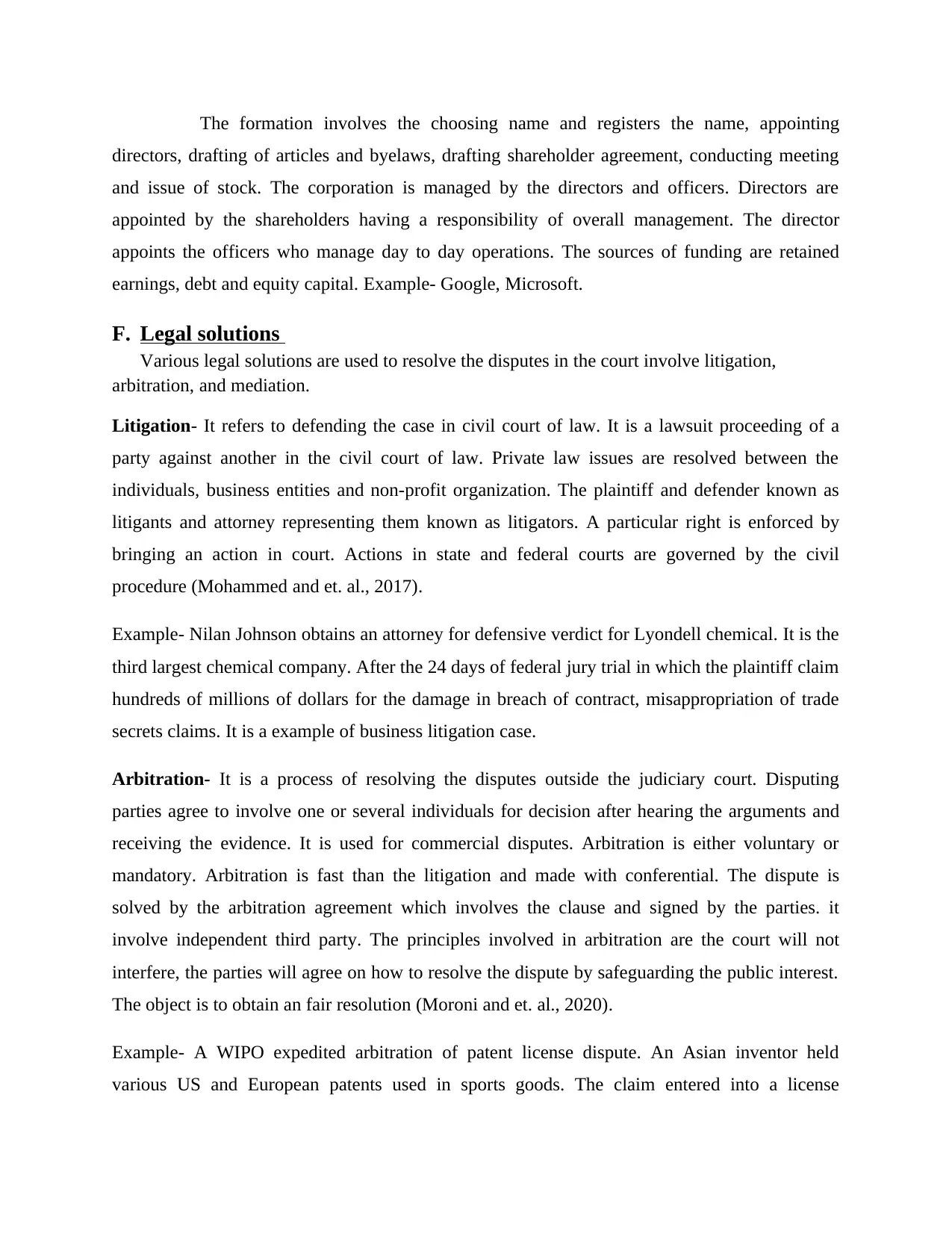
The formation involves the choosing name and registers the name, appointing
directors, drafting of articles and byelaws, drafting shareholder agreement, conducting meeting
and issue of stock. The corporation is managed by the directors and officers. Directors are
appointed by the shareholders having a responsibility of overall management. The director
appoints the officers who manage day to day operations. The sources of funding are retained
earnings, debt and equity capital. Example- Google, Microsoft.
F. Legal solutions
Various legal solutions are used to resolve the disputes in the court involve litigation,
arbitration, and mediation.
Litigation- It refers to defending the case in civil court of law. It is a lawsuit proceeding of a
party against another in the civil court of law. Private law issues are resolved between the
individuals, business entities and non-profit organization. The plaintiff and defender known as
litigants and attorney representing them known as litigators. A particular right is enforced by
bringing an action in court. Actions in state and federal courts are governed by the civil
procedure (Mohammed and et. al., 2017).
Example- Nilan Johnson obtains an attorney for defensive verdict for Lyondell chemical. It is the
third largest chemical company. After the 24 days of federal jury trial in which the plaintiff claim
hundreds of millions of dollars for the damage in breach of contract, misappropriation of trade
secrets claims. It is a example of business litigation case.
Arbitration- It is a process of resolving the disputes outside the judiciary court. Disputing
parties agree to involve one or several individuals for decision after hearing the arguments and
receiving the evidence. It is used for commercial disputes. Arbitration is either voluntary or
mandatory. Arbitration is fast than the litigation and made with conferential. The dispute is
solved by the arbitration agreement which involves the clause and signed by the parties. it
involve independent third party. The principles involved in arbitration are the court will not
interfere, the parties will agree on how to resolve the dispute by safeguarding the public interest.
The object is to obtain an fair resolution (Moroni and et. al., 2020).
Example- A WIPO expedited arbitration of patent license dispute. An Asian inventor held
various US and European patents used in sports goods. The claim entered into a license
directors, drafting of articles and byelaws, drafting shareholder agreement, conducting meeting
and issue of stock. The corporation is managed by the directors and officers. Directors are
appointed by the shareholders having a responsibility of overall management. The director
appoints the officers who manage day to day operations. The sources of funding are retained
earnings, debt and equity capital. Example- Google, Microsoft.
F. Legal solutions
Various legal solutions are used to resolve the disputes in the court involve litigation,
arbitration, and mediation.
Litigation- It refers to defending the case in civil court of law. It is a lawsuit proceeding of a
party against another in the civil court of law. Private law issues are resolved between the
individuals, business entities and non-profit organization. The plaintiff and defender known as
litigants and attorney representing them known as litigators. A particular right is enforced by
bringing an action in court. Actions in state and federal courts are governed by the civil
procedure (Mohammed and et. al., 2017).
Example- Nilan Johnson obtains an attorney for defensive verdict for Lyondell chemical. It is the
third largest chemical company. After the 24 days of federal jury trial in which the plaintiff claim
hundreds of millions of dollars for the damage in breach of contract, misappropriation of trade
secrets claims. It is a example of business litigation case.
Arbitration- It is a process of resolving the disputes outside the judiciary court. Disputing
parties agree to involve one or several individuals for decision after hearing the arguments and
receiving the evidence. It is used for commercial disputes. Arbitration is either voluntary or
mandatory. Arbitration is fast than the litigation and made with conferential. The dispute is
solved by the arbitration agreement which involves the clause and signed by the parties. it
involve independent third party. The principles involved in arbitration are the court will not
interfere, the parties will agree on how to resolve the dispute by safeguarding the public interest.
The object is to obtain an fair resolution (Moroni and et. al., 2020).
Example- A WIPO expedited arbitration of patent license dispute. An Asian inventor held
various US and European patents used in sports goods. The claim entered into a license
Secure Best Marks with AI Grader
Need help grading? Try our AI Grader for instant feedback on your assignments.
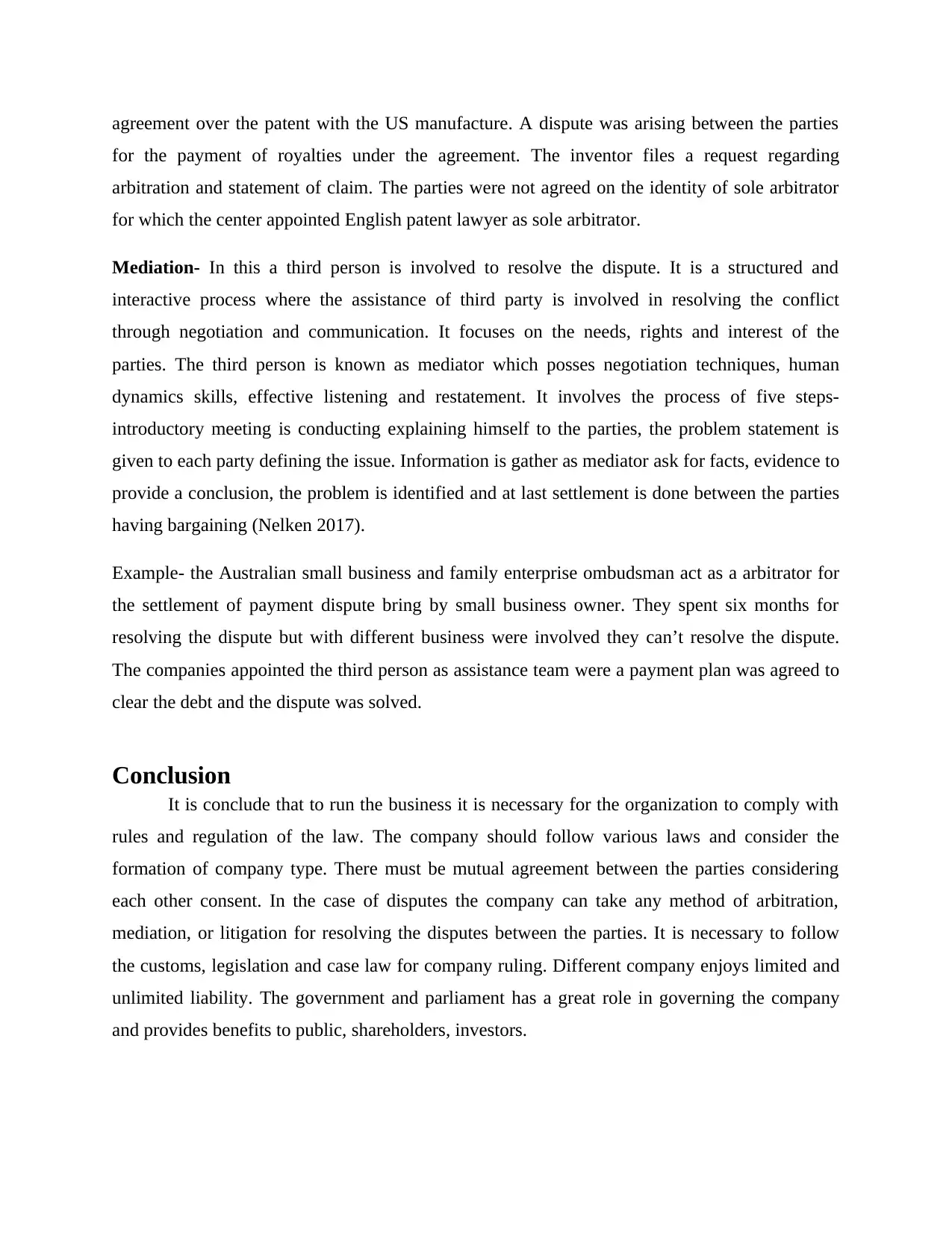
agreement over the patent with the US manufacture. A dispute was arising between the parties
for the payment of royalties under the agreement. The inventor files a request regarding
arbitration and statement of claim. The parties were not agreed on the identity of sole arbitrator
for which the center appointed English patent lawyer as sole arbitrator.
Mediation- In this a third person is involved to resolve the dispute. It is a structured and
interactive process where the assistance of third party is involved in resolving the conflict
through negotiation and communication. It focuses on the needs, rights and interest of the
parties. The third person is known as mediator which posses negotiation techniques, human
dynamics skills, effective listening and restatement. It involves the process of five steps-
introductory meeting is conducting explaining himself to the parties, the problem statement is
given to each party defining the issue. Information is gather as mediator ask for facts, evidence to
provide a conclusion, the problem is identified and at last settlement is done between the parties
having bargaining (Nelken 2017).
Example- the Australian small business and family enterprise ombudsman act as a arbitrator for
the settlement of payment dispute bring by small business owner. They spent six months for
resolving the dispute but with different business were involved they can’t resolve the dispute.
The companies appointed the third person as assistance team were a payment plan was agreed to
clear the debt and the dispute was solved.
Conclusion
It is conclude that to run the business it is necessary for the organization to comply with
rules and regulation of the law. The company should follow various laws and consider the
formation of company type. There must be mutual agreement between the parties considering
each other consent. In the case of disputes the company can take any method of arbitration,
mediation, or litigation for resolving the disputes between the parties. It is necessary to follow
the customs, legislation and case law for company ruling. Different company enjoys limited and
unlimited liability. The government and parliament has a great role in governing the company
and provides benefits to public, shareholders, investors.
for the payment of royalties under the agreement. The inventor files a request regarding
arbitration and statement of claim. The parties were not agreed on the identity of sole arbitrator
for which the center appointed English patent lawyer as sole arbitrator.
Mediation- In this a third person is involved to resolve the dispute. It is a structured and
interactive process where the assistance of third party is involved in resolving the conflict
through negotiation and communication. It focuses on the needs, rights and interest of the
parties. The third person is known as mediator which posses negotiation techniques, human
dynamics skills, effective listening and restatement. It involves the process of five steps-
introductory meeting is conducting explaining himself to the parties, the problem statement is
given to each party defining the issue. Information is gather as mediator ask for facts, evidence to
provide a conclusion, the problem is identified and at last settlement is done between the parties
having bargaining (Nelken 2017).
Example- the Australian small business and family enterprise ombudsman act as a arbitrator for
the settlement of payment dispute bring by small business owner. They spent six months for
resolving the dispute but with different business were involved they can’t resolve the dispute.
The companies appointed the third person as assistance team were a payment plan was agreed to
clear the debt and the dispute was solved.
Conclusion
It is conclude that to run the business it is necessary for the organization to comply with
rules and regulation of the law. The company should follow various laws and consider the
formation of company type. There must be mutual agreement between the parties considering
each other consent. In the case of disputes the company can take any method of arbitration,
mediation, or litigation for resolving the disputes between the parties. It is necessary to follow
the customs, legislation and case law for company ruling. Different company enjoys limited and
unlimited liability. The government and parliament has a great role in governing the company
and provides benefits to public, shareholders, investors.
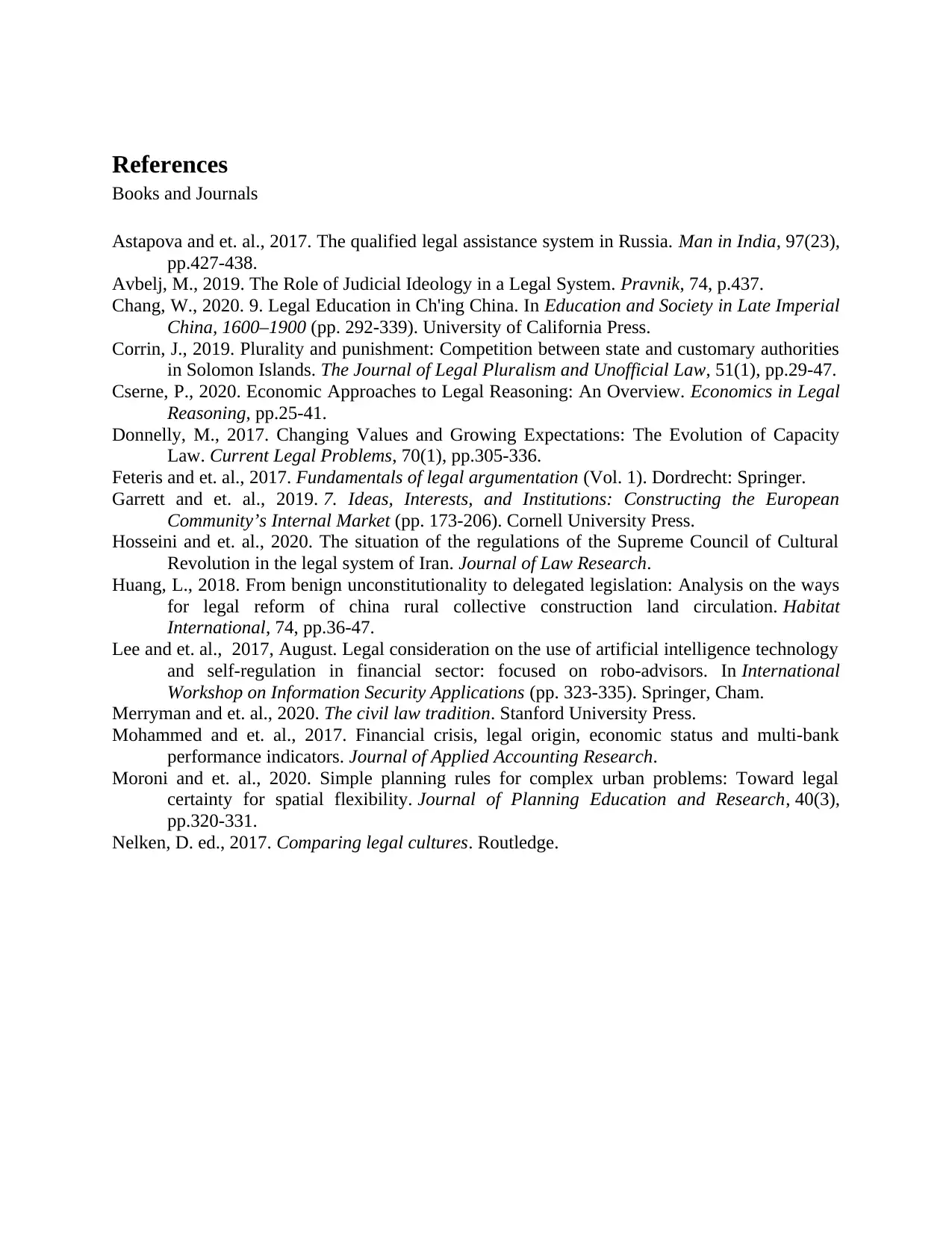
References
Books and Journals
Astapova and et. al., 2017. The qualified legal assistance system in Russia. Man in India, 97(23),
pp.427-438.
Avbelj, M., 2019. The Role of Judicial Ideology in a Legal System. Pravnik, 74, p.437.
Chang, W., 2020. 9. Legal Education in Ch'ing China. In Education and Society in Late Imperial
China, 1600–1900 (pp. 292-339). University of California Press.
Corrin, J., 2019. Plurality and punishment: Competition between state and customary authorities
in Solomon Islands. The Journal of Legal Pluralism and Unofficial Law, 51(1), pp.29-47.
Cserne, P., 2020. Economic Approaches to Legal Reasoning: An Overview. Economics in Legal
Reasoning, pp.25-41.
Donnelly, M., 2017. Changing Values and Growing Expectations: The Evolution of Capacity
Law. Current Legal Problems, 70(1), pp.305-336.
Feteris and et. al., 2017. Fundamentals of legal argumentation (Vol. 1). Dordrecht: Springer.
Garrett and et. al., 2019. 7. Ideas, Interests, and Institutions: Constructing the European
Community’s Internal Market (pp. 173-206). Cornell University Press.
Hosseini and et. al., 2020. The situation of the regulations of the Supreme Council of Cultural
Revolution in the legal system of Iran. Journal of Law Research.
Huang, L., 2018. From benign unconstitutionality to delegated legislation: Analysis on the ways
for legal reform of china rural collective construction land circulation. Habitat
International, 74, pp.36-47.
Lee and et. al., 2017, August. Legal consideration on the use of artificial intelligence technology
and self-regulation in financial sector: focused on robo-advisors. In International
Workshop on Information Security Applications (pp. 323-335). Springer, Cham.
Merryman and et. al., 2020. The civil law tradition. Stanford University Press.
Mohammed and et. al., 2017. Financial crisis, legal origin, economic status and multi-bank
performance indicators. Journal of Applied Accounting Research.
Moroni and et. al., 2020. Simple planning rules for complex urban problems: Toward legal
certainty for spatial flexibility. Journal of Planning Education and Research, 40(3),
pp.320-331.
Nelken, D. ed., 2017. Comparing legal cultures. Routledge.
Books and Journals
Astapova and et. al., 2017. The qualified legal assistance system in Russia. Man in India, 97(23),
pp.427-438.
Avbelj, M., 2019. The Role of Judicial Ideology in a Legal System. Pravnik, 74, p.437.
Chang, W., 2020. 9. Legal Education in Ch'ing China. In Education and Society in Late Imperial
China, 1600–1900 (pp. 292-339). University of California Press.
Corrin, J., 2019. Plurality and punishment: Competition between state and customary authorities
in Solomon Islands. The Journal of Legal Pluralism and Unofficial Law, 51(1), pp.29-47.
Cserne, P., 2020. Economic Approaches to Legal Reasoning: An Overview. Economics in Legal
Reasoning, pp.25-41.
Donnelly, M., 2017. Changing Values and Growing Expectations: The Evolution of Capacity
Law. Current Legal Problems, 70(1), pp.305-336.
Feteris and et. al., 2017. Fundamentals of legal argumentation (Vol. 1). Dordrecht: Springer.
Garrett and et. al., 2019. 7. Ideas, Interests, and Institutions: Constructing the European
Community’s Internal Market (pp. 173-206). Cornell University Press.
Hosseini and et. al., 2020. The situation of the regulations of the Supreme Council of Cultural
Revolution in the legal system of Iran. Journal of Law Research.
Huang, L., 2018. From benign unconstitutionality to delegated legislation: Analysis on the ways
for legal reform of china rural collective construction land circulation. Habitat
International, 74, pp.36-47.
Lee and et. al., 2017, August. Legal consideration on the use of artificial intelligence technology
and self-regulation in financial sector: focused on robo-advisors. In International
Workshop on Information Security Applications (pp. 323-335). Springer, Cham.
Merryman and et. al., 2020. The civil law tradition. Stanford University Press.
Mohammed and et. al., 2017. Financial crisis, legal origin, economic status and multi-bank
performance indicators. Journal of Applied Accounting Research.
Moroni and et. al., 2020. Simple planning rules for complex urban problems: Toward legal
certainty for spatial flexibility. Journal of Planning Education and Research, 40(3),
pp.320-331.
Nelken, D. ed., 2017. Comparing legal cultures. Routledge.
1 out of 12
Related Documents
Your All-in-One AI-Powered Toolkit for Academic Success.
+13062052269
info@desklib.com
Available 24*7 on WhatsApp / Email
![[object Object]](/_next/static/media/star-bottom.7253800d.svg)
Unlock your academic potential
© 2024 | Zucol Services PVT LTD | All rights reserved.





